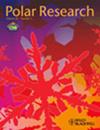Sudden death of an Arctic wolf population in Greenland
IF 1.3
4区 地球科学
Q3 ECOLOGY
引用次数: 2
Abstract
This study reports the disappearance of a small Arctic wolf population in north-east Greenland founded in 1979 and provides the first long-term information on the wolf packs of this region. Data sources comprised specialized wolf surveys in two of three distributional core areas during three summers, 2012–14, and incidental sightings of wolves by military ground patrols during winter and by others year-round. The resulting time series spans 40 years (1979–2018). After gradually increasing for 14 years, the sighting rate peaked in 1996 and then declined to zero after May 2002, suggesting that the population went extinct. The crash occurred despite year-round legal protection in a national park and resulted in a 51.2% reduction in the extent of the occupied wolf range in Greenland and a 41.8% reduction in Greenland’s wolf population size. It was outside the scope of this study to conduct a complete analysis of all potential factors in the disappearance. In north Greenland, a small population of up to 32 wolves during optimal years continues to exist, and dispersers reach north-east Greenland occasionally. A number of measures are proposed that, if implemented by the Greenland Home Rule Government, would help secure the future of the few remaining wolves on the island.格陵兰岛的北极狼种群突然死亡
这项研究报告了1979年在格陵兰东北部发现的一小群北极狼的消失,并首次提供了该地区狼群的长期信息。数据来源包括2012-2014年三个夏季在三个分布核心地区中的两个地区进行的专门的狼调查,以及军事地面巡逻队在冬季和其他全年偶然发现的狼。由此产生的时间序列跨越40年(1979–2018)。经过14年的逐渐增加,该种群的目击率在1996年达到峰值,然后在2002年5月后降至零,这表明该种群已经灭绝。尽管国家公园全年都有法律保护,但这起撞车事故还是发生了,导致格陵兰岛被占领的狼群面积减少了51.2%,格陵兰岛的狼群规模减少了41.8%。对失踪的所有潜在因素进行全面分析超出了本研究的范围。在格陵兰岛北部,在最佳年份,仍有多达32只狼的小种群存在,偶尔会有分散者到达格陵兰岛东北部。提出了一些措施,如果格陵兰自治政府实施这些措施,将有助于确保岛上仅存的几只狼的未来。
本文章由计算机程序翻译,如有差异,请以英文原文为准。
求助全文
约1分钟内获得全文
求助全文
来源期刊

Polar Research
地学-地球科学综合
CiteScore
3.20
自引率
5.30%
发文量
22
审稿时长
>12 weeks
期刊介绍:
Since 1982, Polar Research has been the international, peer-reviewed journal of the Norwegian Polar Institute, Norway''s central institution for research, environmental monitoring and mapping of the polar regions. Aiming to promote the exchange of scientific knowledge about the Arctic and Antarctic across disciplinary boundaries, Polar Research serves an international community of researchers and managers. As an open-access journal, Polar Research makes its contents freely available to the general public.
Original primary research papers comprise the mainstay of Polar Research. Review articles, brief research notes, letters to the editor and book reviews are also included. Special issues are published from time to time.
The scope of Polar Research encompasses research in all scientific disciplines relevant to the polar regions. These include, but are not limited to, the subfields of biology, ecology, geology, oceanography, glaciology and atmospheric science. Submissions from the social sciences and those focusing on polar management and policy issues are welcome. Contributions about Antarctica are particularly encouraged.
 求助内容:
求助内容: 应助结果提醒方式:
应助结果提醒方式:


